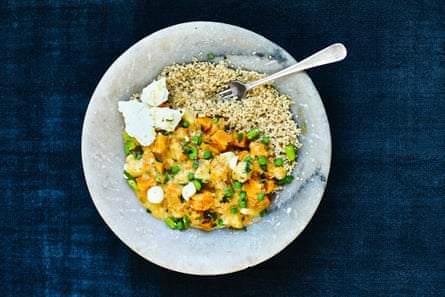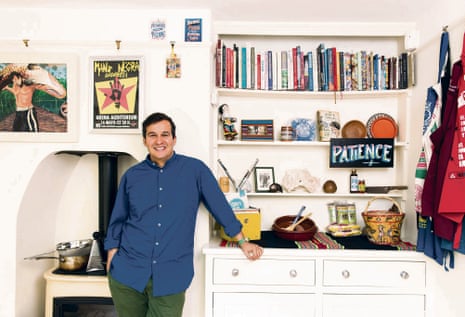Six years ago, we sold our house to start Ceviche in Soho, and moved to this rental. We love it more than any other house we’ve ever lived in. It’s 100m from our kids’ schools, and the kitchen is exactly the style we like: the high ceilings, the picture rails, the old wooden floors ... and that stove! It reminds me of the open fireplaces I used for cooking in the Andes. It’s a coal and woodburning stove, which you can heat things on top of.
The Guardian’s product and service reviews are independent and are in no way influenced by any advertiser or commercial initiative. We will earn a commission from the retailer if you buy something through an affiliate link. Learn more.
I go to Peru several times a year to research recipes and meet chefs, and I bring back a lot of things. This lot of aprons on the wall is a fraction of my collection. Above my head is an amuleto – an Andean good luck charm that you put in your car or bedroom; and the hand-painted basket to my left is from the Huancayo region, given to me by a lady who runs a restaurant called La Tullpa. She taught me how to make an exquisite oyuco potato soup.
I always bring back muna, an Andean herb that’s very calming as a tea; and mote corn, a type of giant kernel corn that is great for slow stews and soups, which are what’s in those packages on the dresser. Tastewise, it’s somewhere between sweetcorn and potato. On one trip to the Amazon, I had the pleasure of trying different dishes based on giant snails, and brought back that shell on the shelf – bigger than a man’s fist.
The kitchen is a place for creativity, fun and happiness; for family, neighbours and friends to come together. As a family we did a workshop with the Carga Maxima artist collective, in Lima. We each chose one of our family values and painted the words – I did “patience” …
Food and music are my biggest loves. We have speakers in every room of the house, a vintage turntable, Sonos, and digital radio. I live in deep west London, but I listen to songs from the deep Andes.
For fun I often buy musically themed cooking utensils: tweezers that look like microphones, wooden spoons that look like drumsticks …
We have our own Ceviche art gallery, showcasing contemporary Peruvian art, so on the kitchen walls I often have works on display. And I also have a big collection of music posters and original photography, mostly Peruvian rock and roll. The Mano Negra poster is from a legendary concert from the 1980s.
I’ve stopped DJing full time, but you can still find me behind the decks in Ceviche Old St on a Thursday night. I only collect 7-inches these days – all retro and analogue; warm crackly fun.
As you can see from the creaking top shelf, I also collect cookbooks, both vintage and new. The Alice B Toklas book contains some crazy recipes – supposedly the first recipe for hashish cake. She was a real bohemian. I found this copy in at the flea market in Paris in Clignancourt, about 15 years ago. Weirdly, I was there again a few weeks ago. I walked in to an area packed with records, and on the turntable was playing Discoteca – a record I produced. My name was on the front cover. The guy was amazed and asked me to sign a copy – then he priced it at 40 euros because he didn’t want anyone to buy it.
I like to bring back little plates from my travels. I have my porridge every day in that beautifully handmade brown one behind the Patience sign – I got it from Monica Alpaca’s restaurant, the picanteria La Nueva Palomino, in Arequipa.
I also had lunch at Jose Lujan’s restaurant in Cuzco a year ago, and he gave me that lump of rock salt from Maras on the second shelf. About 500 people work that part of the Sacred Valley, each on their own little plot, extracting salt by hand from the area where a small hot stream emerges from the earth. It was so heavy to bring back, but I didn’t care - it’s such a poignant memento of our country.
Pumpkin casserole
My great aunt Otilia used to make this locro de zapallo at her house in Lima. It’s an Andina dish by origin, but has variations using different meats all over South America. Served with white quinoa, this is my favourite. You can use white rice, if you prefer. This will make more amarillo chilli paste than you need – the remainder will keep in an airtight jar in the fridge for up to a week.

Serves 4-6
2 tbsp olive oil
1 onion, finely chopped
1 garlic clove, finely chopped
1 tbsp amarillo chilli paste (see below)
½ tsp dried oregano
500g pumpkin or butternut squash, peeled and cut into 4cm cubes
1 large potato, peeled and cut into 25mm cubes
250ml vegetable stock
50g broad beans
50g choclo corn kernels or sweetcorn kernels
50g peas
100ml single cream or evaporated milk
50g white quinoa, cooked
100g queso fresco or feta, crumbled
A handful of flat-leaf parsley, chopped
Salt and black pepper
For the chilli paste (makes about 100ml)
1 tbsp olive oil
¼ onion, finely chopped
2 garlic cloves, finely chopped
2 amarillo chillies, or 2 medium-heat red chillies and ½ yellow pepper, deseeded and finely chopped
1 First, make the amarillo chilli paste. Fry the onion over a medium heat for 7-8 minutes until soft, but not browned. Add the garlic and chilli, then fry for 2-3 minutes more. Season, then let it cool completely. Blitz to a smooth paste, then set aside until needed.
2 Saute the onion in a large saucepan or casserole over a low heat for about 10 minutes, or until soft, then add the garlic, 1 tbsp of the chilli paste and the oregano. Stir for a 2-3 minutes, until the garlic has softened slightly and everything is well combined.
3 Add the butternut squash, potato and vegetable stock. Bring to the boil, then reduce the heat, cover and simmer for 15 minutes until the butternut squash and potato are just tender and the liquid has reduced a little.
4 Add the broad beans, the corn kernels, and the peas, cover again and simmer for 5 minutes more until the broad beans are just tender.
5 Add the single cream or evaporated milk and stir to combine. Cook for a further 1-2 minutes, uncovered, to heat through. Season with salt and pepper.
6 Serve the stew in shallow bowls with the quinoa and the cheese on the side, and sprinked with a little chopped parsley.
Oxapampa tart
Historic Germanic migration to the Pasco region in the Andes gave Peruvians this dramatic dessert. You can use bananas instead of the plantains. Serve it with single cream or ice-cream.

Serves 6–8
230g plain flour
125g butter
25g muscovado sugar
For the filling
15g butter
2 small or 1 large, ripe plantain, peeled and diced
1 medium-large banana, peeled
75g mascarpone
2 eggs
For the topping
1 small green plantain, peeled and cut in half widthways
1 cinnamon stick
3 star anise
½ tsp bicarbonate of soda
For the butterscotch
60g light soft brown sugar
½ limo chilli or 2 medium-heat red chilli, deseeded and chopped
1 tsp ground ginger
2 tbsp freshly squeezed orange juice
6 black peppercorns
150g caster sugar
50g butter
1 Mix flour, butter and sugar together, then form into a soft pastry ball. Wrap in clingfilm and chill until needed.
2 To make the filling, melt the butter in a small frying pan over a low heat. Add the diced plantain and fry, stirring, for 4-5 minutes, or until they are lightly golden. Set aside to cool, then blitz to a puree along with the banana. Add the mascarpone and eggs. Blitz again to a smooth, pourable mixture. Set aside.
3 To make the topping, put the plantain halves in a saucepan and cover with water. Add the cinnamon and star anise. Bring to the boil on a high heat. Add the bicarbonate of soda, then reduce the heat and simmer for 15 minutes, or until al dente. Drain and slice the plantain into 1cm-thick rings. Set aside.
4 To make the butterscotch, put the light-brown sugar, chilli, ground ginger, orange juice and peppercorns into a small saucepan with 10cm of water over a medium heat. Bring to the boil, then reduce the heat to low and simmer very gently for 10 minutes, or until the sugar has dissolved and the liquid has reduced to a syrupy consistency. Strain the syrup into a bowl. Set aside.
5 Melt the caster sugar in a heavy-based saucepan over a medium heat, shaking it so that it covers the base evenly and resisting the urge to stir. When it has turned a light golden brown (about 6-7 minutes), reduce the heat, then add the butter. Whisk to a smooth sauce, then add in the spicy syrup. Whisk again to a rich caramel. Set aside.
6 Set the oven to 170C/335F/gas 3. Take a 23cm-wide nonstick ovenproof skillet or shallow nonstick tin. Pour in the butterscotch, top with plantain slices and cover with the filling.
7 Roll out the pastry, then lay it on the filling. Tuck in the edges. Slit the dough to let the steam escape. Bake for 30 minutes, or until golden. Rest for 1 minute, then turn out the tart. Serve in slices.
- Martin Morales is an award-winning Peruvian chef, cookbook author and restaurateur (and DJ); @martinceviche. This is an extract from Andina: the Heart of Peruvian Food (Hardie Grant) – out now.

Comments (…)
Sign in or create your Guardian account to join the discussion